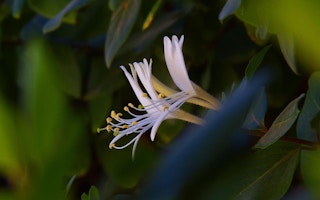For decades, Sobirin provided for his family by picking flowers here on the north coast of Indonesia’s Java Island. Now in his 70s, much of the farmer’s income used to grow near the beach on a large plot of jasmine, Jasminum sambac, the so-called “queen of flowers” cherished by royal dynasties from Ancient Egypt to China’s Sung Dynasty.
“This is the area for jasmine, the Kandang Panjang area,” Sobirin told Mongabay Indonesia at his home by the Java Sea.
Jasmine is commonly used to flavour tea and as an offering in devotional ceremonies. The aromatic flower is believed sacred to Vishnu, a god in the Hindu religion.
“The quality is second to none,” Sobirin said in the Javanese language, when asked to describe the flowers grown in this low-lying region of Central Java province.
But in recent years Sobirin’s children have implored their father to move away from the coast of Kandang Panjang village, which is located around 80 kilometres (50 miles) west of Semarang, the provincial capital.
Like much of Java’s north coast, the land here is gradually sinking and the high tide is becoming higher.
Sobirin has raised the floor of his house on three occasions since a storm surge inundated the community in 2010. The ceiling of his home, which once stood 3.5 metres (11.5 feet) high, is now just 2 m (6.5 ft) above the floor as a result of this repeated building.
The father of five received 7 million rupiah (US$450) from the government to adapt his home to the rising water, but he otherwise relies on money sent from his children. The threat of coastal erosion is such that his land is worth only around 10,000 rupiah (60 cents) per square metre, or about 6 cents per square foot.
Local government official Aji told Mongabay Indonesia that almost all northern Pekalongan district’s agricultural land and aquaculture ponds were permanently inundated by the sea following the 2010 storm surge.
“
Move to where? What would be their source of income in the new location? They’ve made peace with the disaster, but not everyone can do that.
Sella Lestari Nurmaulia, lecturer, Bandung Institute of Technology
“Now there are probably only one or two ponds that are still active,” Aji said. “The others have all gone under.”
Dead flowers
Traders from other areas of Java used to come to Pekalongan looking for jasmine, but the flower economy wilted as saltwater inundated the soil.
Java’s coastal jasmine growers aren’t alone in confronting rising sea levels and erosion of their coastline.
A 2018 study published in the journal Scientific Reports showed that as much as 28,000 square kilometres (11,000 square miles) of land had been destroyed worldwide by coastal abrasion, an area 10 times larger than Hong Kong. Research in the same journal reported that rising sea levels will “radically redefine the coastline of the 21st century.”
Another study, which looked at sea levels in 99 coastal cities from 2015-2020, found Semarang was one of the fastest-sinking major cities in the world.
Most families living by the Pekalongan coast today rely on pumps to purge brine that often invades their homes. Costly efforts to build a stone barrier between the village and the Java Sea have had little impact.
Eko Teguh Paripurno, who oversees the disaster management master’s degree program at UPN Veteran Yogyakarta, said adaptation to changing coastlines was rarely straightforward. Some farmers in the community have tried adapting to the changing environment by focusing on aquaculture and vertical farming. In theory, Eko said, efforts to lower the salt content in local freshwater could enable productive plants to grow in the affected soil.
“Nothing is impossible — it’s just whether it’s economical,” he said.
Jasmine growers used to be seen every morning picking flowers from the land in Pekalongan.
“Sometimes 10 kilos [22 pounds], other days 5 kilos [11 lbs],” Sobirin said. “It varied.”
However, Sobirin was unable to continue his work after the seawater inundated the soil where he grew jasmine. Today, he runs a small business renting plastic baskets used at local ceremonies. The baskets are stacked in his home beneath his increasingly low ceiling.
He has so far resisted the pleas from his children to move. Research has shown a large share of people like Sobirin impacted by coastal erosion choose to stay put, despite the risks and economic damage.
Sella Lestari Nurmaulia, a lecturer at the Bandung Institute of Technology, said transferring families to new locations was fraught with difficulties, including the emotional attachment generations usually feel to their homes.
“Move to where? What would be their source of income in the new location?” Sella said.
“They’ve made peace with the disaster, but not everyone can do that.”
This story was published with permission from Mongabay.com.

















